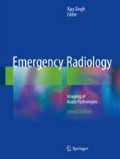Abstract
Nuclear medicine (NM) can play important primary and secondary roles in diagnosis and management in the emergency setting. Within the radiological armamentarium, selected scintigraphic examinations offer significant value because those negative examinations exclude diagnoses with high certainty, while positive examinations direct appropriate management. Currently, common radionuclide imaging examinations of the thorax and abdomen in the emergency setting are ventilation/perfusion (V/Q) lung scintigraphy, myocardial perfusion imaging (MPI), hepatobiliary scintigraphy (HBS), and gastrointestinal (GI) bleeding including Meckel’s diverticulum scintigraphy.
References
Mansi L, Rambaldi PF, Cuccurullo V, Varetto T. Nuclear medicine in emergency. Q J Nucl Med Mol Imaging. 2005;49:171–91.
Sostman HD, Miniati M, Gottschalk A, Matta F, Stein PD, Pistolesi M. Sensitivity and specificity of perfusion scintigraphy combined with chest radiography for acute pulmonary embolism in PIOPED II. J Nucl Med. 2008;49:1741–8.
Amini B, Patel CB, Lewin MR, Kim T, Fisher RE. Diagnostic nuclear medicine in the ED. Am J Emerg Med. 2011;29:91–101.
Uliel L, Mellnick VM, Menias CO, Holz AL, McConathy J. Nuclear medicine in the acute clinical setting: indications, imaging findings, and potential pitfalls. RadioGraphics. 2013;33:375–96.
Forberg JL, Hilmersson CE, Carlsson M, Arheden H, Bjork J, Hjalte K, et al. Negative predictive value and potential cost savings of acute nuclear myocardial perfusion imaging in low risk patients with suspected acute coronary syndrome: a prospective single blinded study. BMC Emerg Med. 2009;9:12.
Rybicki FJ, Udelson JE, Peacock WF, Goldhaber SZ, Isselbacher EM, Kazerooni E, et al. 2015 ACR/ACC/AHA/AATS/ACEP/ASNC/NASCI/SAEM/SCCT/SCMR/SCPC/SNMMI/STR/STS appropriate utilization of cardiovascular imaging in emergency department patients with chest pain. J Am Coll Radiol. 2015;13:e1–e29.
Kontos MC. Myocardial perfusion imaging in the acute care setting: does it still have a role? J Nucl Cardiol. 2011;18:342–50.
Chatziioannou SN, Moore WH, Ford PV, Dhekne RD. Hepatobiliary scintigraphy is superior to abdominal ultrasonography in suspected acute cholecystitis. Surgery. 2000;127:609–13.
Ziessman HA. Hepatobiliary scintigraphy in 2014. J Nucl Med. 2014;55:967–75.
Wahl WL, Brandt MM, Hemmila MR, Arbabi S. Diagnosis and management of bile leaks after blunt liver injury. Surgery. 2005;138:742–7; discussion 747–8.
Brunnler T, Klebl F, Mundorff S, Eilles C, Reng M, von Korn H, et al. Significance of scintigraphy for the localisation of obscure gastrointestinal bleedings. World J Gastroenterol. 2008;14:5015–9.
Currie GM, Kiat H, Wheat JM. Scintigraphic evaluation of acute lower gastrointestinal hemorrhage: current status and future directions. J Clin Gastroenterol. 2011;45:92–9.
Dam HQ, Brandon DC, Grantham VV, Hilson AJ, Howarth DM, Maurer AH, et al. The SNMMI procedure standard/EANM practice guideline for gastrointestinal bleeding scintigraphy 2.0. J Nucl Med Technol. 2014;42:308–17.
Spottswood SE, Pfluger T, Bartold SP, Brandon D, Burchell N, Delbeke D, et al. SNMMI and EANM practice guideline for meckel diverticulum scintigraphy 2.0. J Nucl Med Technol. 2014;42:163–9.
Swaniker F, Soldes O, Hirschl RB. The utility of technetium 99m pertechnetate scintigraphy in the evaluation of patients with Meckel’s diverticulum. J Pediatr Surg. 1999;34:760–4. discussion 765
Freeman LM, Stein EG, Sprayregen S, Chamarthy M, Haramati LB. The current and continuing important role of ventilation-perfusion scintigraphy in evaluating patients with suspected pulmonary embolism. Semin Nucl Med. 2008;38:432–40.
Kontos MC, Tatum JL. Imaging in the evaluation of the patient with suspected acute coronary syndrome. Semin Nucl Med. 2003;33:246–58.
Udelson JE, Beshansky JR, Ballin DS, Feldman JA, Griffith JL, Handler J, et al. Myocardial perfusion imaging for evaluation and triage of patients with suspected acute cardiac ischemia: a randomized controlled trial. JAMA. 2002;288:2693–700.
Kontos MC, Schmidt KL, McCue M, Rossiter LF, Jurgensen M, Nicholson CS, et al. A comprehensive strategy for the evaluation and triage of the chest pain patient: a cost comparison study. J Nucl Cardiol. 2003;10:284–90.
Ziessman HA. Interventions used with cholescintigraphy for the diagnosis of hepatobiliary disease. Semin Nucl Med. 2009;39:174–85.
Fleming KW, Lucey BC, Soto JA, Oates ME. Posttraumatic bile leaks: role of diagnostic imaging and impact on patient outcome. Emerg Radiol. 2006;12:103–7.
Mittal BR, Sunil HV, Bhattacharya A, Singh B. Hepatobiliary scintigraphy in management of bile leaks in patients with blunt abdominal trauma. ANZ J Surg. 2008;78:597–600.
O’Neill BB, Gosnell JE, Lull RJ, Schecter WP, Koch J, Halvorsen RA, et al. Cinematic nuclear scintigraphy reliably directs surgical intervention for patients with gastrointestinal bleeding. Arch Surg. 2000;135:1076–81. discussion 1081–2
Mellinger JD, Bittner JG, Edwards MA, Bates W, Williams HT. Imaging of gastrointestinal bleeding. Surg Clin North Am. 2011;91:93–108.
Howarth DM. The role of nuclear medicine in the detection of acute gastrointestinal bleeding. Semin Nucl Med. 2006;36:133–46.
Author information
Authors and Affiliations
Corresponding author
Editor information
Editors and Affiliations
Rights and permissions
Copyright information
© 2018 Springer International Publishing AG
About this chapter
Cite this chapter
Lumby, C., von Herrmann, P.F., Oates, M.E. (2018). Emergency Radionuclide Imaging of the Thorax and Abdomen. In: Singh, A. (eds) Emergency Radiology. Springer, Cham. https://doi.org/10.1007/978-3-319-65397-6_14
Download citation
DOI: https://doi.org/10.1007/978-3-319-65397-6_14
Published:
Publisher Name: Springer, Cham
Print ISBN: 978-3-319-65396-9
Online ISBN: 978-3-319-65397-6
eBook Packages: MedicineMedicine (R0)

